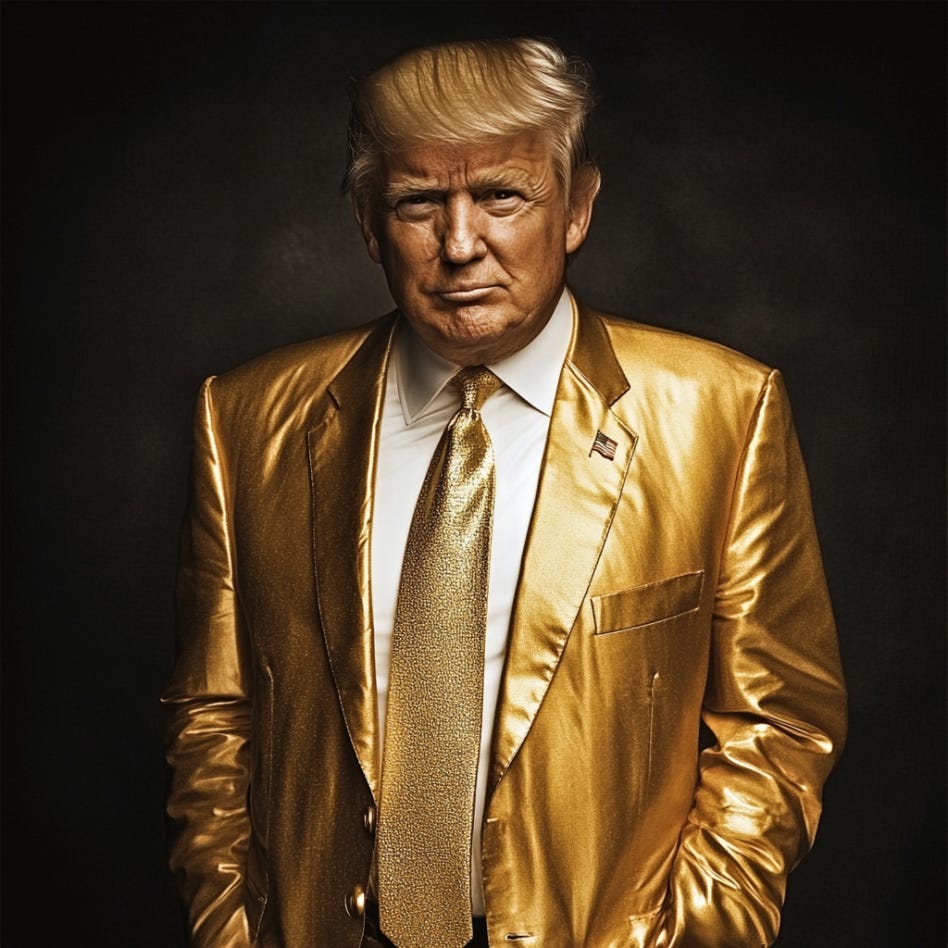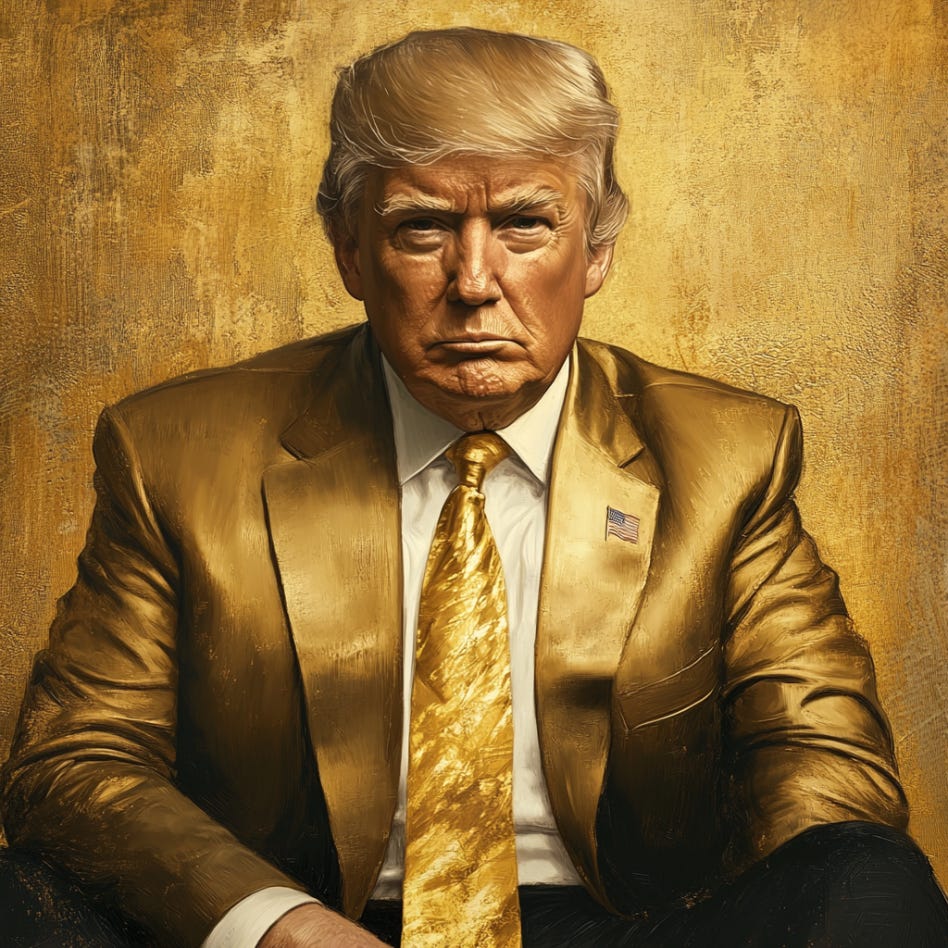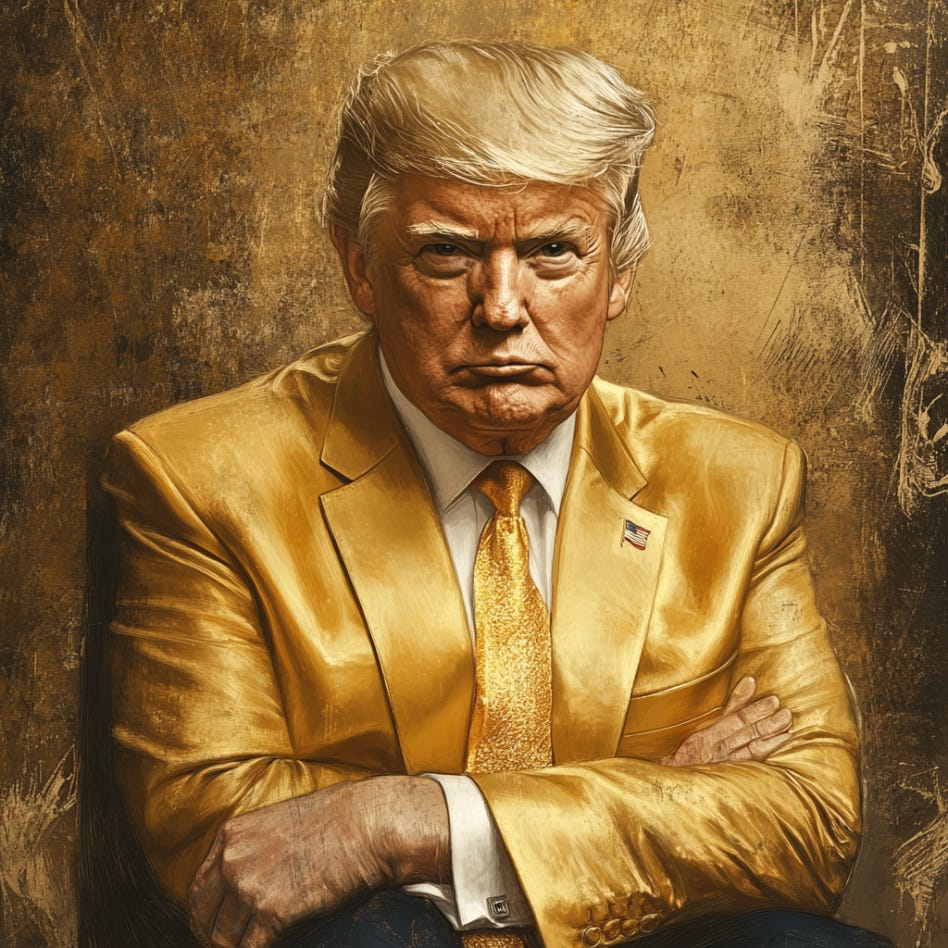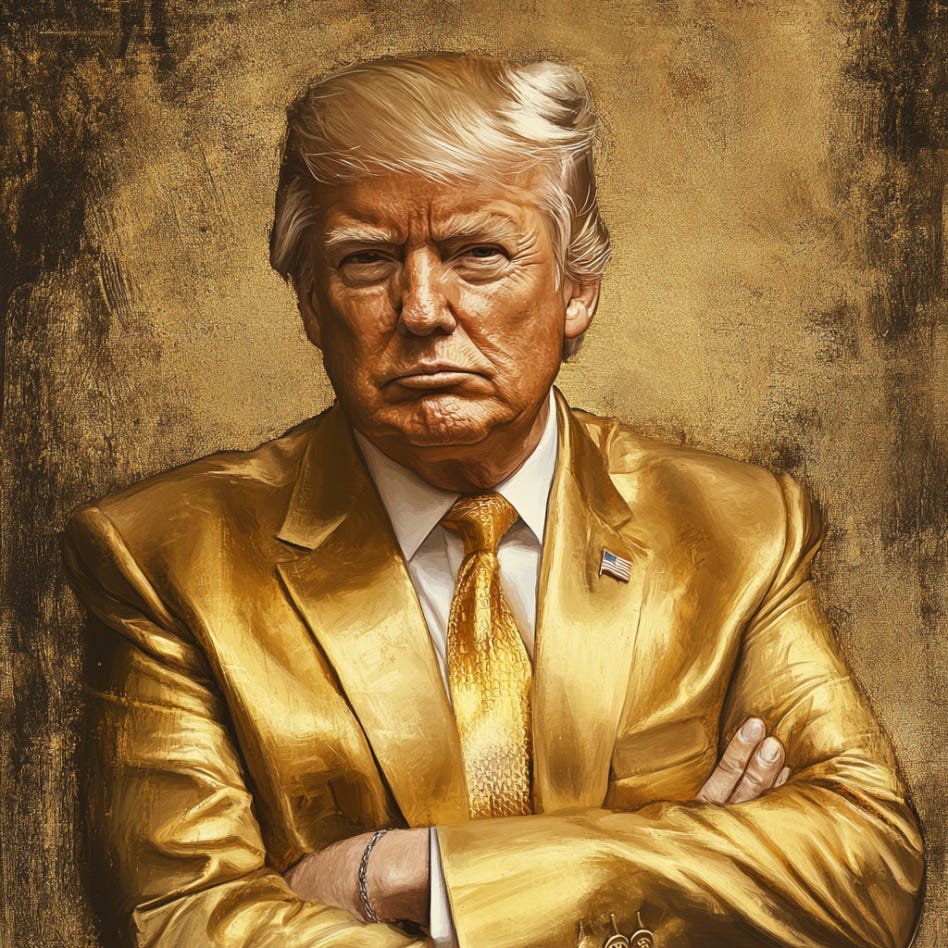Trump's $5M "Gold Card" Visa: U.S. Citizenship for High Net Worth Foreigners & Global Elites
A fairly neutral move by Trump if replacing EB-5, slight negative for revenue... ideal plan would keep EB-5 and add the Gold Card
Trump recently announced a United States “Gold Card” visa (green card) wherein foreigners will be able to purchase a path to U.S. citizenship for $5 million — pretty straightforward.
If you’re an ultra-high-net-worth individual (UHNWI), “global elite,” wealthy foreigner, etc. — you can buy your way into the U.S. — and as along as you follow some simple rules, the U.S. gov will grant you full citizenship rights.
I didn’t scan social media for reactions to this announcement, but I’m guessing the Democrats, Liberals, Left-Wingers hate it because Trump is involved and they think he’s selling out the U.S. to foreign money launderers and oligarchs… no clue how they reacted though.
I’m guessing that Republicans, Conservatives, Right-Wingers had mixed reactions with a faction liking it because Trump did it and because it will attract more wealth to pay off debt, bring in potentially talented high IQ businessmen & investors, etc. — and that another subset dislikes it because of Chinese spies and more competition for homegrown pure-blooded/thoroughbred Americans.
My thoughts on the “Gold Card” are fairly basic… I think it’s a neutral move by Trump as long as they have contingencies in place to prevent the CCP/Russia seeding spies with $5M with the intent of siphoning key R&D/IP from the U.S. (this is usually par for the course with these things).
This visa will attract people with a lot of money — such that the immigrants are immediately a fiscal net positive (taxpayers aren’t footing healthcare, education, food, housing, etc.) like they’ve been doing for illegals, refugees, asylum seekers, etc. — and the effects of these individuals should compound over time (local/federal taxes, setting up businesses, etc.).
Trump hyped up the potential of the visa suggesting that if he gets 10 million “Gold Card” buyers per year — the U.S. will get an injection of $50T — far more than the National Debt. The problem? There aren’t even 5 million people worldwide with $5M+ net worth.
There are estimated to be ~3-5 million people globally with $5M+ net worths… and of these people only a fraction will likely choose to get a U.S. Gold Card. For the Gold Card to make sense, pursuants will need net worths far greater than $5M.
>$10M net worth: ~584k individuals worldwide (2023)
>$30M net worth: ~226k individuals worldwide (2023)
A woman on X/Twitter posted something along the lines of:
“If any foreign men want a discount on the Gold Card you can marry me — I’ll only charge $4 million.”
The main reason I think this “Gold Card” is somewhat neutral is because he plans to use it to replace the EB-5 visa… it is unlikely to pass the net benefit of the EB-5 so technically could be slightly worse overall even if less fraud.
The most optimal strategy would be: keep EB-5 while cracking down harder on fraud/misuse/abuse AND add the “Trump Gold Card” to attract a different demographic… this would a smarter plan because you’d generate more total revenue than eliminating the EB-5 (even if a subset transition to the Gold Card).
I. Trump Gold Card Visa ($5 Million)
A.) Announcement & Proposed Start Date
Announcement: Donald Trump unveiled the Trump Gold Card on February 25, 2025, stating this new investor-immigration pathway would replace the existing EB-5 program.
Effective Date: Trump indicated it would launch “in 2 weeks” from the announcement, placing the start around March 11, 2025.
Potential Delays: Official regulations or final administrative logistics could shift this date slightly, but March 11 is the provisional target.
B.) Core Structure
Investment Requirement: Each applicant must invest USD 5 million in the United States.
Residency and Citizenship Path: In return, applicants receive a “Gold Card,” conferring U.S. permanent residency (a Green Card) and eventually a route to U.S. citizenship.
No Job-Creation Mandate: Unlike EB-5, there is no requirement to prove creation (or preservation) of 10 jobs. This simplification is a major departure from EB-5.
Replacement of EB-5: The Trump Gold Card is slated to supersede EB-5 entirely, meaning new investors will follow the new structure rather than the old program.
II. Rationale for the $5M Gold Card Trump Visa
A.) Revenue Generation & Debt Reduction
Trump has publicly claimed large numbers of ultra-wealthy investors could provide significant capital inflows, potentially to help reduce the $35+ trillion national debt.
In interviews, he has occasionally spoken of “billions” or even “trillions” of dollars that might come in.
B.) Simplicity & Prestige
No job-creation requirement aims to eliminate red tape and attract more participants.
Labeling it a “Gold Card” underscores exclusivity and leverages Trump’s personal brand.
By setting the bar at $5 million, the administration positions it as an ultra-premium residency path, presumably appealing to the global elite.
C.) Comparison to Other Countries’ “Golden Visas”
Many nations (e.g., Portugal, Greece, Malta, Cyprus) offer residency or citizenship by investing as little as a few hundred thousand dollars (or euros).
$5 million is far higher than most international “golden visa” thresholds, banking on the U.S. market’s desirability and Trump’s brand recognition.
III. Trump Gold Card vs. EB-5 Visa
The 2 programs offer distinct pathways to long‑term U.S. residency for foreign investors.
While the Gold Card raises the investment bar to $5 million and eliminates the job‑creation requirement, EB‑5 uses a lower investment threshold (typically $800,000–$1.05 million) but requires that each investor create 10 full‑time jobs.
EB-5 vs. Gold Card (Objective Analysis)
Total Influx & Investor Base:
EB‑5: Attracts a larger number of investors (around 8,000 per year) at a lower cost, enabling broader participation and capital inflow.
Gold Card: Although each investor contributes $5 million, its high cost limits participation to only 1,500–2,500 ultra‑wealthy individuals.
Compounding Effects & Economic Multipliers:
EB‑5: Direct investments often lead to significant job creation and additional private-sector activity, creating multiplier effects that boost local economies and tax revenues.
Gold Card: Provides predictable, direct revenue to the government; however, without a job creation mandate, its broader economic stimulus relies on how government allocates these funds post-receipt.
Effects on National Debt:
Both programs yield inflows that are small compared to the $35+ trillion national debt. Even with additional multiplier effects, neither program is likely to dramatically reduce federal debt on its own.
Fraud & Oversight:
EB‑5: Has faced notable issues with fraud and mismanagement, which have eroded investor confidence and diluted its intended benefits.
Gold Card: Aims to reduce these risks with a direct payment structure and stricter vetting, although the exact mechanisms remain to be fully implemented and proven.
Processing Speed & Administrative Efficiency:
EB‑5: Suffers from long wait times and significant backlogs, which frustrate investors and delay economic benefits.
Gold Card: Promises a faster, more streamlined residency process, a major selling point for investors who value speed over lower cost.
Which is Better for the USA?
EB‑5 Program:
Advantages: Broader participation, substantial job creation, and strong private-sector multiplier effects lead to significant local economic growth.
Disadvantages: High incidence of fraud, mismanagement, and severe processing delays reduce its overall effectiveness.
Trump Gold Card Visa:
Advantages: Offers a fast, transparent, and fraud‑resistant path to U.S. residency with predictable, high‑value revenue for the government.
Disadvantages: Its high $5M cost limits participation to a small, ultra‑wealthy group and it lacks the built‑in economic multiplier effect of mandatory job creation.
Optimal Strategy for the USA: Maintaining both programs—with enhanced oversight measures—appears optimal.
This dual‑track system would allow the country to:
Capture Broad Capital Inflows: Continue to benefit from EB‑5’s wider investor base and its associated job creation and private sector stimulation.
Secure Predictable Revenue: Utilize the Gold Card for rapid, high‑value capital inflows from UHNWIs, ensuring a stable fiscal contribution.
Mitigate Fraud Risks: Enhance regulatory oversight across both programs to reduce fraud and ensure the integrity of investments.
Ultimately, while EB‑5 offers broader economic benefits through its multiplier effects, its drawbacks (fraud and delays) are significant. The Gold Card provides a cleaner, more efficient process, but its limited reach restricts its overall impact.
Therefore, a combined approach—reforming EB‑5 to address its shortcomings while leveraging the efficiency of the Gold Card—could maximize benefits for the U.S. economy.
IV. Estimated Applicant Numbers & Demographics
A.) Global Pool of Wealthy Investors
Roughly 3–5 million people worldwide have net worths exceeding $5 million (or at least as of 2023… likely higher now).
However, not all hold sufficient liquid assets or desire U.S. residency (especially given tax implications).
B.) Estimated Annual Applicants
EB-5 peaked at around 8,000 applicants annually at lower thresholds.
With a $5 million requirement but no job-creation rules, experts predict around 1,500 to 2,500 applicants per year—a smaller pool but presumably more straightforward to process.
This translates to $7.5–$12.5 billion total annually if each invests the full $5 million.
C.) Regional Sources
We must consider countries that are sufficiently wealthy and have large populations to guess which cohorts will most likely take advantage of this visa.
I’m sure there will be some weird conspiracy theories here, but as long as the visa holders aren’t criminals, voting for socialism/communism, or engaged in espionage… bring as many over as are willing to assimilate.
China: Historically dominant (40–50% of EB-5). Likely to remain the top source despite geopolitical tensions and potential additional scrutiny.
India: Growing population of millionaires/entrepreneurs.
Russia: Oligarchs and wealthy elites may pursue it, though sanctions and U.S. relations complicate matters.
Middle East (e.g., Saudi Arabia, UAE): Significant oil wealth; interest in U.S. security/stability.
Europe (EU): Some portion of high-net-worth individuals in the UK, Germany, France, etc., may still choose the U.S. for business or personal reasons.
Latin America: Typically a modest portion (Brazil, Mexico, etc.).
Sex & Age: Historically, principal applicants skew male (especially in emerging markets), often aged 40–70+ with established wealth. Female participation does exist and could grow.
V. Bring the Entire Fam to the U.S. with a Gold Card?
It seems logical to assume that one’s entire family can get U.S. citizenship with the Trump Gold Card visa. This is a good thing. Families are probably less likely to engage in criminality/spying etc. — we also need more smart kids.
Immediate Family: Under standard U.S. “employment-based” or “investor-based” green card rules, the principal applicant’s spouse and unmarried children under 21 are included as derivative beneficiaries.
Extended Family: Parents, siblings, adult or married children typically are not covered under the principal investor’s application. They would require separate sponsorship or visas.
Likely to Mirror EB-5: The Trump Gold Card is expected to follow this same derivative policy, meaning one $5 million investment grants green cards for the investor, their spouse, and under-21 unmarried children.
VI. Estimated Economic Impact & Effect on U.S. Deficit (National Debt)
A.) Projected Inflows
1,500–2,500 investors per year × $5 million = approx. $7.5–$12.5 billion annual inflows.
B.) Size of U.S. National Debt
The national debt stands at $35+ trillion, and annual deficits can exceed hundreds of billions (or even surpass $1 trillion).
$10 billion is only around 0.03% of $35 trillion—an insignificant fraction in terms of true debt reduction.
C.) Where Will the $5M Go?
It’s important to emphasize that the $5 million is not an investment that the applicant directs—it is a mandated fee paid to the government.
Direct Payment to the Government: The applicant pays $5 million as part of the visa fee. This money becomes a source of revenue for the federal government. Unlike a private investment where the investor chooses how to deploy funds, here the allocation is determined by government policy and budgeting priorities.
Government Allocation and Economic Effects: Once received, these funds might be used by the government in a variety of ways. For example, the government could:
Invest in U.S. Treasury Bonds: The funds might be placed in government bonds, which provide liquidity and generate interest income. Although this creates a liability (the need to repay principal plus interest), it still injects capital into the federal coffers.
Support Federal Programs: Alternatively, the revenue might be directed toward public projects or deficit reduction initiatives.
Stimulate Broader Economic Activity: Even if not directly “spent” in the traditional sense, the presence of additional capital may have indirect multiplier effects on the economy through increased government spending or through confidence effects that spur private investment.
Indirect Multipliers: The analysis of indirect or compounding benefits focuses on how this government revenue, once allocated, can generate further economic activity. For instance, if the funds help reduce borrowing costs or are channeled into infrastructure or innovation projects, they might indirectly boost job creation, consumer spending, and tax revenues—even though the applicant has no say in these allocation decisions.
D.) Long-Term Considerations
Best Case: Wealthy investors become entrepreneurs, create jobs, pay significant taxes, and stimulate new economic activity.
Worst Case: Many just “park” funds in safe assets (Treasury bonds, high-end real estate) with minimal multiplier effects.
Minimal Debt Impact: While a few billion dollars in new investment each year is helpful, it cannot meaningfully solve the $35 trillion debt. Even with annual repetition, the scale is too small relative to federal spending.
VII. U.S. Gold Card Abuse, Espionage Concerns
A.) Common Concerns
Money Laundering/Illicit Funds: Large sums can attract unscrupulous applicants seeking to launder money.
Espionage: Wealthy individuals from adversarial nations (e.g., certain Chinese or Russian nationals) might leverage the visa as a strategic advantage.
Fraud: EB-5 saw instances of fraud and misuse of funds (e.g., fake “regional centers”). The Trump Gold Card must address similar risks.
B.) Planned Vetting Measures
Stricter Source-of-Funds Audits: Applicants must thoroughly document legitimate origins of the $5 million.
Enhanced Background Checks: The FBI, DHS, CIA, and possibly other intelligence agencies will vet applicants for security red flags.
Country-Specific Scrutiny: High-risk or sanctioned countries may face extra layers of review, or certain nationals might be restricted altogether.
Corporate Sponsorship: Trump mentioned companies could pay the $5 million on behalf of “star talent,” but details are murky and could introduce further complexity.
C.) No System Is Foolproof
Sophisticated shell companies or proxies could still obscure true funding sources or beneficial owners.
Critics remain skeptical whether these promised “stricter oversight” procedures will be enforced stringently or if political influences may undermine them.
VIII. Trump’s “10 Million Investors” Hype
Trump has hyped the idea that if 10 million people each contributed $5 million, the resulting $50 trillion would exceed the entire national debt (~$35 trillion).
Obviously that would be excellent, but as we know there are probably less than 5 million people with $5M worldwide… and most of them don’t want to spend it on the Gold Card.
Furthermore, even if you got 10 million the first year, it would be impossible to continue getting 10 million more each subsequent year… and the debt keeps growing. Usually what happens is: Gov gets more $ → Gov spends more $ → Deficit increases.
Reality:
EB-5 saw ~8,000 applicants per year at its peak.
Reaching 10 million new investor-immigrants would be astronomically beyond any historical or realistic figure.
Global distribution of wealth plus competing immigration programs make such a scenario effectively impossible.
IX. Potential Compounding Effects & Indirect Benefits
Beyond the initial $5 million per investor, there are knock‑on economic impacts that can meaningfully expand the program’s total contribution to the U.S. economy, albeit still modest compared to the $35+ trillion debt.
Additional Capital Investment
Many ultra‑wealthy immigrants do not stop at $5 million. They may deploy further amounts into real estate developments, tech startups, franchises, or venture capital.
Illustrative Estimate: Suppose 25–40% of the 2,000 annual arrivals invest an extra $1–2 million each. That alone adds $500 million–$1.6 billion in additional U.S. capital inflows beyond the initial “entry fee.”
Household Spending & Personal Taxes
High‑End Consumption: Once settled, wealthy families typically spend on homes, private schools, cars, services, etc.
Tax Revenues: Substantial federal, state, and local taxes on incomes, property, and sales.
Example: If each new investor‑family has $250k in annual spending and pays $50–75k in combined taxes, 2,000 families could generate $500 million in consumer outlays plus $100+ million in taxes per year, recurring over multiple years.
Business Formation & Job Creation (Voluntary)
Unlike EB‑5, the Gold Card does not mandate job creation, but many investors will establish businesses or invest in existing ones.
Historical EB‑5 data suggests each $1 million can create 6–12 direct + indirect jobs. Even a fraction of Gold Card holders who become active entrepreneurs could spark localized job growth and long‑term tax revenues.
Innovation & “Network Effects”
Some arrivals might bring niche expertise, forging cross‑border partnerships or expansions that wouldn’t otherwise happen.
This intangible “talent infusion” can benefit U.S. tech hubs, finance sectors, and other high‑growth areas.
Economic Multipliers
Macro analyses often show that $1 of fresh investment or spending can yield $1.5–$2 in broader GDP impact (“multiplier effect”).
If the direct $5 million × 2,000 = $10 billion inflow each year is multiplied by ~1.5, the economy‑wide effect might be $15 billion, before including further entrepreneurial ventures or extra capital injections.
While the Gold Card’s direct $7.5–$12.5 billion yearly inflow garners the headlines, follow‑on spending, taxes, business expansions, and job creation can significantly boost the program’s total economic contribution. Over multiple years, these indirect benefits often outstrip the initial $5 million per investor—especially if a sizable share become active investors or entrepreneurs, rather than purely passive wealth‑parkers.
Still, even with such added multipliers, the overall scale remains limited relative to the $35+ trillion federal debt. From a microeconomic standpoint, localities or regions with heavy concentrations of Gold Card investors could see notable growth spurts and tax windfalls, but from a macroeconomic or federal‑debt perspective, it is too small to truly offset multi‑trillion‑dollar deficits.
X. U.S. Gold Card (Trump Visa) Summary
Launch Date: Aiming for March 11, 2025 (two weeks post-announcement).
Investment Threshold: $5 million—far above EB-5’s $800k–$1 million.
No Job Creation Requirement: A big departure from EB-5.
Family Inclusion: Spouse and unmarried children under 21—no extended relatives.
Applicant Demographics: Predominantly from China, India, Russia, parts of the Middle East, and wealthy segments of Europe.
Estimated Annual Volume: Around 1,500–2,500 applicants, yielding $7.5–$12.5 billion.
Deficit Impact: Minimal; billions per year barely dent a $35+ trillion debt.
Potential Abuses: Fraud, money laundering, espionage; the government promises stringent vetting.
Corporate Sponsorship: Possible but details remain unclear.
XI. Trump’s U.S. “Gold Card” Visa (Takeaways)
Overall, the Trump Gold Card is a pricier, streamlined successor to EB-5—promising fewer bureaucratic barriers, more exclusivity, and a potential “fast track” to citizenship.
It will likely attract a modest (albeit lucrative) pool of global elites each year, thereby delivering some economic benefits and headlines.
However, its direct impact on the U.S. deficit or national debt will be negligible, and robust safeguards will be essential to prevent abuses by criminals or foreign intelligence agents. Further regulatory clarifications are expected in the coming months as the program’s final details solidify.
High-End Investor Visa, Not a Debt Panacea: The Trump Gold Card sets a high bar ($5 million) and removes job-creation hassles, aiming to lure ultra-wealthy foreigners. While this can bring in billions of dollars each year, it cannot meaningfully fix the $35 trillion U.S. debt.
Family Inclusion Limited to Spouse & Minor Children: Consistent with standard U.S. green card rules, the Trump Gold Card will almost certainly allow each principal investor to include a spouse and unmarried children under 21. Other relatives (parents, siblings, adult children) need separate paths.
Global Competition & Security Risks: The U.S. stands out with brand appeal but competes with cheaper golden visas in Europe and elsewhere. Additionally, a $5 million pay-to-play visa invites concerns about money laundering, espionage, and fraud—issues the administration vows to address through heightened vetting.
Realistic Volume, Realistic Impact: Expert projections suggest around 1,500–2,500 applicants a year, translating to $7.5–$12.5 billion annually—significant but small relative to national budgetary shortfalls. Over time, a portion of these investors may generate additional economic contributions (job creation, taxes, consumer spending), but it remains a niche program serving an ultra-wealthy cohort.
My thoughts? The EB-5 visa is has a history of fraud and abuse, but it’s still a significant net benefit for the U.S. Elimination of EB-5 in favor of a Trump “Gold Card” will likely be less beneficial than keeping the EB-5 (if head-to-head comparison)… hopefully am wrong on this take though.
Ideally I think the smartest move for Trump is to keep the EB-5 program AND add the Trump “Gold Card” visa to attract different clientele. Espionage, fraud, and abuse will happen regardless of visa options available — the goal is maintain strict oversight and crack down a bit harder.
I think the “Gold Card” visa and EB-5 are likely to attract types of people who align with the original ethos that made the U.S. great (freedom, free markets, capitalism).
But getting rid of the EB-5 in favor of the “Gold Card” is likely a slight net negative… Trump will market it as “way better” and his lapdogs will eat it up… it’s not bad, but the higher IQ play would be crack down harder on EB-5 fraud, keep the EB-5 and add the Gold Card.
Both these are a helluva lot better than allowing drug cartels, foreign criminal gangs, and randoms cross the border with zero desire to assimilate (learn English, work hard, etc.) — and degrade the quality of the U.S. while committing crimes, collecting free housing, healthcare, food stamps, etc. at the expense of taxpayers.
Note: U.S. should consider experimenting with pricing based on number of annual applicants to achieve max revenue (while being mindful of potential compounders). If we can attract the same number of people at $10M per Gold Card as $5M then $5M is underselling it. Should also consider future adjustments for inflation every so many years (probably baked in).











